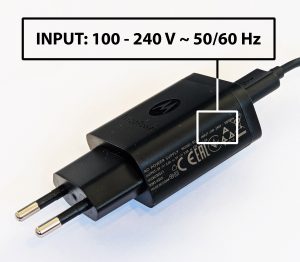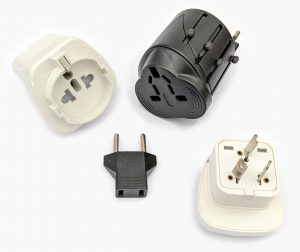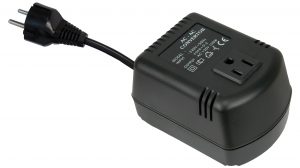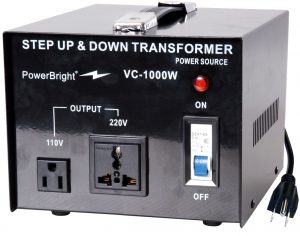Useful information for travellers

Only use plug adapters if the local mains voltage is the same as at home or if you need to power a multi-voltage device. The above charger is multi voltage: it will work with any voltage between 100 and 240 volts.

Travel adapters do NOT convert the voltage!
What do I need to use my appliances abroad?
What do I need to use my appliances abroad? What is the difference between a plug adapter and an electric converter? Here are the facts. First the good news: in many cases you may not need to carry much with you at all...
Plug adapters (or travel adapters)
Travel adapters simply allow a device from one country to be plugged into the wall outlet of another country. However, they do not convert electricity. The plug of a Continental European appliance will not fit into an outlet in a foreign country without a plug adapter. Since a travel adapter does not convert the voltage, you have to be sure that your appliance can deal with the electricity coming out of the socket. That is why you need to check your device's voltage listing. "INPUT: 100-240 V" means that your device is multi-voltage and that it will work with any voltage between 100 V and 240 V. Luckily, many travel gadgets (such as laptops or phone chargers) are multi or dual voltage, so you will only need a travel adapter. If your device is single voltage (e.g. "INPUT: 120V") and you are in Europe where the mains voltage is 230 V, you will need to step down the voltage. Enter the converter or transformer.
 Converters and transformers both step up or down the voltage, but there is a difference in use between them. Converters should be used only with "electric" products. Electric products are simple heating devices or have mechanical motors. Examples are hair dryers, steam irons, shavers, toothbrushes or small fans. Converters are not designed for "continuous duty" and should only be used for short periods of time (1 to 2 hours). Additionally, most converters can only be used for ungrounded appliances (2 pins on the plug). Converters must be unplugged from the wall when not in use.
Converters and transformers both step up or down the voltage, but there is a difference in use between them. Converters should be used only with "electric" products. Electric products are simple heating devices or have mechanical motors. Examples are hair dryers, steam irons, shavers, toothbrushes or small fans. Converters are not designed for "continuous duty" and should only be used for short periods of time (1 to 2 hours). Additionally, most converters can only be used for ungrounded appliances (2 pins on the plug). Converters must be unplugged from the wall when not in use. The appliance’s voltage and wattage requirements are listed on the manufacturer's label located on the back or at the bottom of the appliance. In some cases, the voltage and amperage will be listed, but not the wattage. If this is the case, simply multiply the voltage by the amperage rating to find the wattage rating (e.g. 230 V * 2 A = 460 W).
The appliance’s voltage and wattage requirements are listed on the manufacturer's label located on the back or at the bottom of the appliance. In some cases, the voltage and amperage will be listed, but not the wattage. If this is the case, simply multiply the voltage by the amperage rating to find the wattage rating (e.g. 230 V * 2 A = 460 W). In case you forget to check what the local voltage is in the country you’re going to: here’s a small trick. Just take a look at the glass of an ordinary light bulb or stop at a supermarket and note what is printed on a light bulb packet!
In case you forget to check what the local voltage is in the country you’re going to: here’s a small trick. Just take a look at the glass of an ordinary light bulb or stop at a supermarket and note what is printed on a light bulb packet!


